'India Week' - Popular Tools
First of all, I will mention the newspaper. Lots of things you buy in the street are wrapped in newspaper: snacks, vegetables, souvenirs... Newspaper is used to absorb the grease of an oily snack or to keep humidity away from fruits and vegetables. This was one of the early culture shockers for me: noticing a street vendor handing out snacks wrapped in newspaper, including an extra piece for a napkin (i.e. 'tissue paper') or finding something in the refrigerator wrapped in last week's news! I have to admit that the use of newspaper is very environmentally friendly, but in Costa Rica we don't use it to wrap anything edible. Instead, we use aluminium foil, wax (oven) paper or kitchen paper towels. These products are also being promoted here in India through some adds I've seen lately.
This picture shows a bag made out of newspaper. It was used to wrap some souvenirs that MasalaDad brought me from one of his recent business trips.

The next picture is a coconut scraper. Coconut is an important ingredient in several Indian dishes. Coconuts are widely sold and used in various ways: to drink its water, to scrape its flesh and use it as an ingredient in recipes and even to offer them to a deity in a temple or in the shrines that people keep in their houses. Coconut oil is also very popular for head massages: it's suppossed to help cool off and help make the hair shiny and healthy. The left-hand side of the following picture shows one type of coconut scraper. The right-hand side shows the scraper with a tray of coconut flesh and red chillies. These ingredients were later added to a dish of fish curry. When Ishan's mother saw me taking a picture of this, she was curious and asked me how do we scrape the coconut in Costa Rica. I told her coconut is mainly used in some desserts and we just get packages of it at the supermarket.
(Click image to enlarge.)
Behold the 'Indian broom'! They come in different sizes; some are made of harsh straw to sweep exteriors and some are softer to sweep indoors. If you're not used to these types of brooms it can be very harsh on your back: you have to bend or squat. However, if you're used to them, you will do a better sweeping job than with a 'western' broom. I've also seen versions of the 'Indian broom' that have a long stick attached to it and they’re used to sweep the streets or construction sites. Nowadays, you can also find the same design made out of plastic and therefore, in different colors!
If you're not from India, I challenge you to guess what the object in the next picture is! To me it looks like a weapon, but it's actually a board to hit the clothes as they're being washed. That's right! The clothes are soaked in soapy water and then 'punished' to get the dirt out. I wonder who came up with this system?!...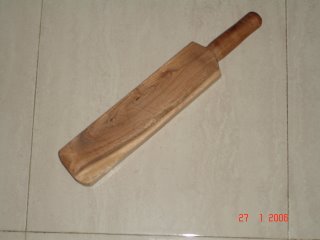 Here's another interesting object that looks like it belongs in a mechanical shop or in a dentist's office, but it actually belongs in the kitchen. Read on...
Here's another interesting object that looks like it belongs in a mechanical shop or in a dentist's office, but it actually belongs in the kitchen. Read on... This is a common cooking vessel (i.e. pot), made of steel just like many other cooking utensils. Some vessels also are made of aluminium or copper, but have the same style as the one shown in the picture.
This is a common cooking vessel (i.e. pot), made of steel just like many other cooking utensils. Some vessels also are made of aluminium or copper, but have the same style as the one shown in the picture. Since these utensils get hot while cooking, the 'plyers' shown before are used to hold the hot vessels, just as shown in the picture. I’ve seen two different types of plyers. They’re not difficult to use.
Since these utensils get hot while cooking, the 'plyers' shown before are used to hold the hot vessels, just as shown in the picture. I’ve seen two different types of plyers. They’re not difficult to use.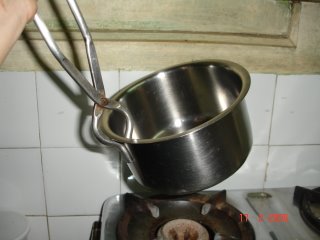 Here's a view of a common dishholder found in many Indian homes. Shiny, isn't it? I told you steel was popular!
Here's a view of a common dishholder found in many Indian homes. Shiny, isn't it? I told you steel was popular! Chapatis are the ‘daily bread’ around here. Fresh homemade chapatis are quite popular eventhough you can also get them readymade and heat them in the microwave. The dough is made out of wheat flour, oil and salt. A little ball of dough is then extended on a round board with the roller stick (seen in the picture below) and then placed on the stove until the chapati is ready. Other chapati-makers are also available, which guarantee the outcome of a round chapati from the dough. The Costa Rican version of chapatis would be the ‘tortillas’, which are also flat and round but made out of corn flour. Traditionally, fresh ones would be made every day and women used nothing except the palms of their hands to make perfectly round tortillas. Now they’re mainly bought readymade.
Chapatis are the ‘daily bread’ around here. Fresh homemade chapatis are quite popular eventhough you can also get them readymade and heat them in the microwave. The dough is made out of wheat flour, oil and salt. A little ball of dough is then extended on a round board with the roller stick (seen in the picture below) and then placed on the stove until the chapati is ready. Other chapati-makers are also available, which guarantee the outcome of a round chapati from the dough. The Costa Rican version of chapatis would be the ‘tortillas’, which are also flat and round but made out of corn flour. Traditionally, fresh ones would be made every day and women used nothing except the palms of their hands to make perfectly round tortillas. Now they’re mainly bought readymade.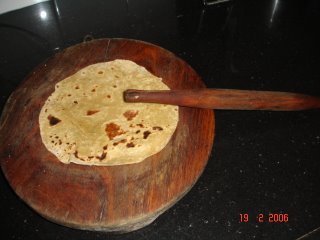 Just thought I’d post a picture of Fabi getting familiar with the board and roller stick to make chapatis. Notice he’s sitting on the kitchen floor next to his grandmother right before cooking a batch of chapatis. Also notice the newspaper sheet under the board – to protect the floor.
Just thought I’d post a picture of Fabi getting familiar with the board and roller stick to make chapatis. Notice he’s sitting on the kitchen floor next to his grandmother right before cooking a batch of chapatis. Also notice the newspaper sheet under the board – to protect the floor.
This next picture shows two ‘dabbas’ (hindi word for lunch) or ‘tiffins’ (old fashioned English word for lunch box). They come in different sizes and have separate compartments to store the food, usually, rice, dal, a vegetable item, a salad and of course, chapatis. Many people who work in Mumbai city order their homemade-style lunch that they get in dabbas. This is so common, that there are people known as ‘dabbawallas’ (meaning, the one who carries dabbas) who are in charge of delivering these lunches to office buildings.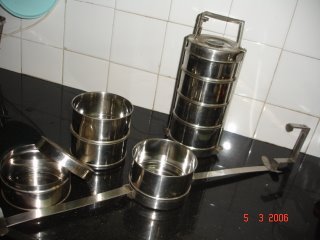
When I used to work here in India, MasalaDad and I ordered our dinner in a dabba. People don’t need a lot of furniture here in India and are comfortable eating while sitting down on the floor. I took this picture with my camera phone. It shows the sitting arrangement. Notice the newspaper sheet on the floor and the steel plate, cup and spoon on Ishan’s side. Those were my earlier days here, now we have a table and real placemats (that match my Corelle set!)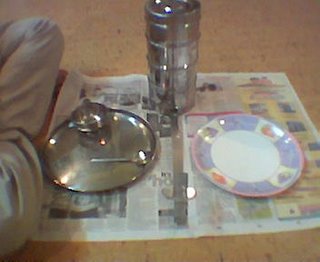 This last tool is not necessarily ‘Indian’, but it’s very useful here in (Navi) Mumbai, where the swampy area is the perfect place for all those mosquitoes to grow. When you wave this racket and press the button on the handle, an electric shock kills the mosquitoes that come in contact with it. Now that summer is here, the number of mosquitoes has come down significantly. I’m very glad because even though Fabi slept under a mosquito net, he sometimes got bitten during the day.
This last tool is not necessarily ‘Indian’, but it’s very useful here in (Navi) Mumbai, where the swampy area is the perfect place for all those mosquitoes to grow. When you wave this racket and press the button on the handle, an electric shock kills the mosquitoes that come in contact with it. Now that summer is here, the number of mosquitoes has come down significantly. I’m very glad because even though Fabi slept under a mosquito net, he sometimes got bitten during the day.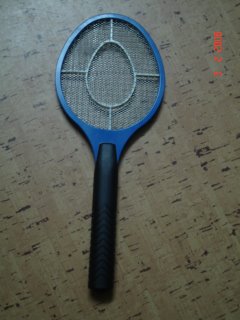
Labels: Life in India



4 What say? / Que me dicen? - Comments:
hey Mari,
interesting Blog, ya very true newspaper is a very integral part of indian life, coconut cutter is very interesting actually in North India we dont use so much coconut in food so this is my first view of it, n the indian Brooms they are a good exercise :-) as well,
its so nice to see the tiny details of indian life expalined so well,
n Hey Mari was missing chaat and lukily today someone had made paani puri for our Holi gettogteher, it was yummy , just wanted to share the info with you:-)
your blog made me smile, seeing the beautiful pictures was enough :) .. well I came from Shweta and Rajeev's blog (btw I don't know them either)... It looks like you are new to India and having a lot of fun !
Hi! I completely relate with the coconut grater because they use a lot of coconut at my parent's place ( goan food just like in your household ).But since Rajeev is a Punjabi he doesn't have coconut at all!! So here in Mumbai even I don't have a grater! But now from this month I have started incorporating the Goan cuisine at home and yes Rajeev is enjoying it!!
The board to hit the clothes to wash them was widely used in Europe and up to the time when my grand-mother was young!
The word in French is "battoir" from to "beat" (I think the English word for this board is a "beetle", not sure, though). The French word was traced back as far as the 13th Century!! Old thing!
I love the lunch boxes, so practical and quite environmental friendly as well!
Post a Comment
<< Home